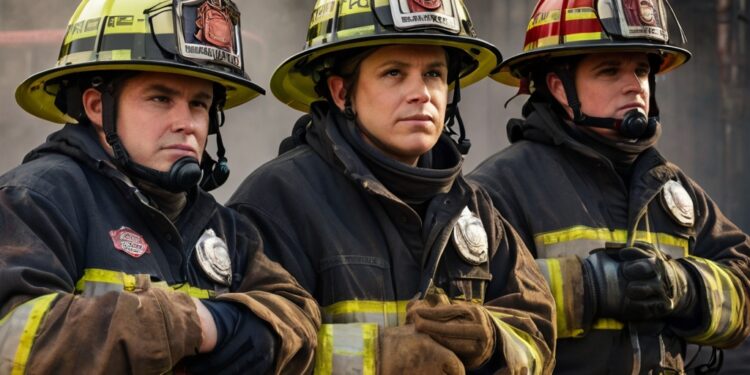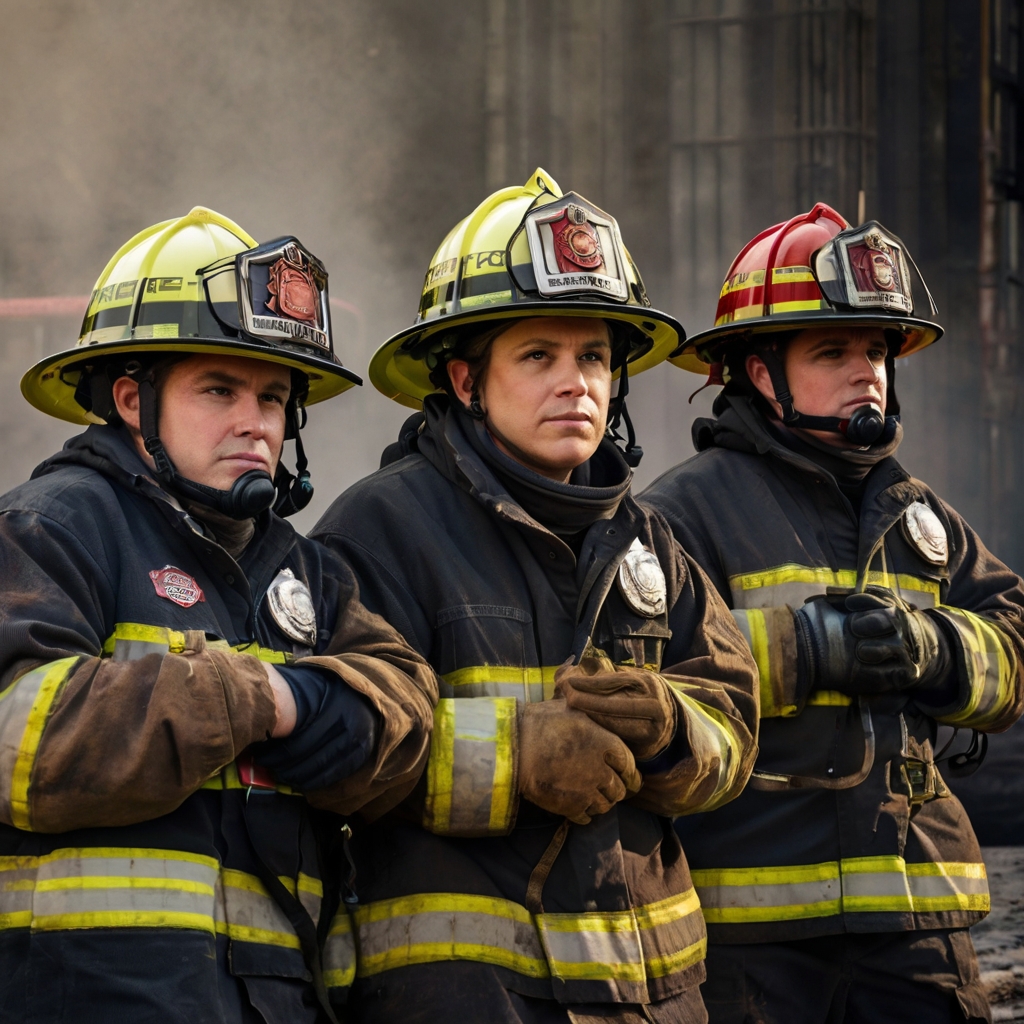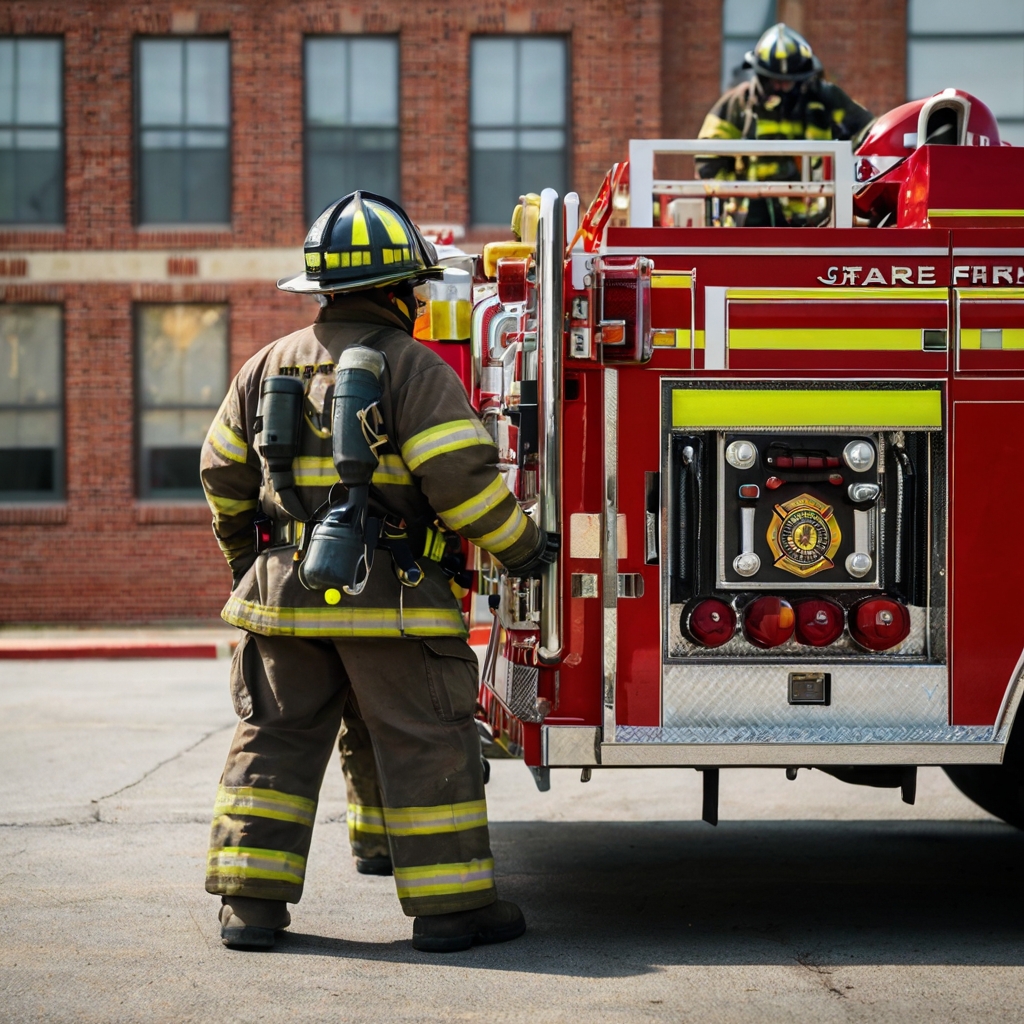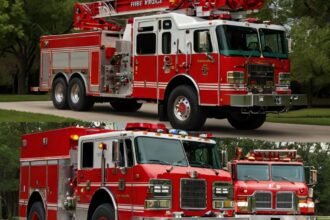Firefighter Ranks

The fire service’s rank structure dates back to 1647. It started as a paramilitary organization with a clear chain of command. This structure still shapes career advancement, duties, and pay scales in fire departments nationwide. New Probationary Firefighters start at $44,117 per year. This is a big deal as it means that Assistant Chiefs can earn up to $321,073, which shows the career’s growth potential.
Anyone looking to build a career in firefighting needs to know the department’s ranks. The chain of command has several distinct positions. It starts with Firefighter and moves up through Driver Engineer, Lieutenant, Captain, and Battalion Chief. The top position is Fire Chief. Each rank comes with its own insignias. A firefighter’s helmet color shows their position and authority level. This piece gets into the fire service’s rank structure, each position’s responsibilities, and what you can expect to earn. It will help you direct your path to a successful firefighting career.

Table of Contents
- 1 Understanding the Firefighter Rank Structure
- 2 Firefighter Ranks in Order Explained
- 3 Fire Department Units and Their Roles
- 4 Firefighter Ranks and Salary Insights
- 5
- 6 Climbing the Ladder: Career Progression Tips
- 7
- 8 Navigating Your Firefighting Career Path
- 9 Here are some FAQs about the firefighter ranks:
- 9.1 What are the ranks of firefighters lowest to highest?
- 9.2 What is the hierarchy of fire?
- 9.3 What is the highest firefighter job?
- 9.4 Why are American firefighters also paramedics?
- 9.5 What is the most elite firefighter?
- 9.6 What is a rank 5 fire?
- 9.7 What are the 4 levels of fire?
- 9.8 What country has the best firefighters?
- 9.9 What are the fire rating levels?
Understanding the Firefighter Rank Structure
Fire departments have one of the oldest and most effective emergency response systems in public safety. Their organizational framework sets them apart. Unlike modern workplaces that accept flatter structures, fire departments stick to a strict hierarchical system based on military organizations for good operational reasons.
Why fire departments follow a paramilitary model
The paramilitary model dates back to 1647 and laid the groundwork for the firefighter rank structure we know today. This organizational approach serves specific operational needs that remain relevant in modern firefighting.
The paramilitary structure gives exceptional control during emergency scenes. Teams can coordinate better during chaotic incidents because everyone knows their role and reporting relationships through the established firefighter chain of command. This clarity becomes vital when firefighters face life-threatening situations that need quick action.
Clear accountability comes from this structured approach. Specific responsibilities belong to each rank within the fire department ranks in order. Critical tasks get assigned and completed without confusion. Teams pay attention to detail at every service level because of this accountability.
Quick decisions happen faster when seconds count in this hierarchical system. One experienced firefighter put it well: “You wouldn’t want to be arguing about decisions when a burning building is staring you in the face.” Teams know exactly who makes final decisions during emergencies because authority lines are clear.
The organization keeps an appropriate span of control – usually between 3-7 direct reports per supervisor. This management ratio helps both safety and effectiveness during emergency operations. Commanding officers don’t get overwhelmed with information.
The rank structure shows a clear career path that rewards experience, education, and proven skills. The defined firefighter ranks and salary progression motivates professionals and guides their career growth.
How the chain of command works in fire service
The fire department ranks create a hierarchical structure that helps smooth operations in emergencies and daily activities. Authority, responsibility, and communication flow systematically through this chain of command.
The progression typically follows these ranks of firefighters from bottom up:
- Probationary Firefighter (“probie” or “rookie”)
- Firefighter
- Driver Engineer
- Lieutenant
- Captain
- Battalion Chief
- Assistant/Deputy Chief
- Fire Chief
A clear reporting structure emerges as each rank reports to the one above. This system prevents chaos during emergencies by creating one source for instructions and updates. Orders move down through ranks while situation reports move up.
The fireman ranks make emergency response quick through specialized roles. The incident command system kicks in right away when responding to a fire. Command usually starts with the first company officer on scene. They assess the situation and deploy resources based on standard protocols.
Battalion Chiefs take charge as incident commanders for bigger events. They coordinate multiple companies and make sure resources go where needed. The lieutenant firefighter connects strategic planning with tactical execution. They turn captain’s orders into practical tasks for firefighters.
Many departments blend this traditional structure with shared approaches during non-emergency operations. Fire departments can keep the benefits of hierarchy while adapting to modern management this way.
The firefighter helmet color ranks give quick visual cues about authority levels in chaotic emergency scenes. This visual system works with verbal and procedural elements to make operations smoother when time matters most.
This organizational framework matters not just for firefighters but also for community members who work with local departments. The straightforward fire dept ranks let teams mobilize quickly and efficiently. Accountability stays high, helping maintain excellent service standards during emergencies.
Firefighter Ranks in Order Explained
The path to climb firefighter ranks follows a clear progression. You need proven skills, testing, and dedicated service time at each level. This career path gives aspiring firefighters a clear picture of how to grow professionally.
Probationary Firefighter
Your first step starts as a probationary firefighter, known as “probie” or “rookie.” This entry-level position lasts 12-18 months. It serves as an extended evaluation period and hands-on training. Probies learn their department’s protocols and become skilled at station duties. They go through regular evaluations and blend into their station’s culture. A supervisor watches them closely. They must show technical skills, flexibility, strong work ethic, and team spirit to succeed in fire service.
Firefighter
After completing probation, you earn the full firefighter title. This permanent position needs expertise in fire suppression, search and rescue, ventilation, and forcible entry. Most departments require firefighters to be certified Emergency Medical Technicians (EMTs) or Paramedics. They build expertise in areas like hazardous materials response, technical rescue, or wildland firefighting. They also check buildings, teach the public, and take care of the station. Senior firefighters help train new members and take on special tasks based on their skills.
Driver Engineer
The driver engineer—also called apparatus operator or fire equipment operator—is the first step up in many departments. This role needs extra certification beyond firefighter qualifications. They drive and position emergency vehicles safely. They must understand complex hydraulics to control fire streams, manage water supply, regulate pressure, and maintain equipment. Engineers know every alarm and hydrant location in their area. They are the department’s go-to experts for all things related to fire apparatus.
Lieutenant
Lieutenants mark the shift from team member to leader. They run tactical operations, assess safety risks, train staff, handle paperwork, ensure rules are followed, and roll out department programs. Good lieutenants can take charge during emergencies and work well with the team during quiet times. This rank often proves the toughest to adjust to. It needs new skills in delegation, accountability, and broader thinking. Lieutenants step in as acting captains when needed.
Captain
Captains run their stations and lead their companies. They manage the building, supervise staff, command emergency scenes, oversee training, handle community relations, and implement policies. They bridge the gap between front-line teams and upper management. Captains must communicate well in both directions while juggling tactical needs with staff management. Many specialize in areas like training, EMS, or fire prevention.
Battalion Chief
Battalion Chiefs (or District Chiefs) oversee several companies across multiple stations in their area. They think more about strategy than tactics. They lead multi-company incidents, manage station resources, create response plans for high-risk areas, supervise captains, work with other emergency services, and implement department goals. They work 24-hour shifts to provide round-the-clock leadership. They’re often the highest-ranking officer on duty at night and on weekends.
Assistant Chief
Assistant Chiefs run major department functions or geographic divisions. They typically handle operations, training, fire prevention, administration, EMS, or special operations. They work Monday through Friday but remain on call for major incidents. They help the Fire Chief maintain high standards, manage budgets, run community programs, and oversee the department. This role needs both technical expertise and organizational skills.
Fire Chief
The Fire Chief leads the entire fire department. As the executive leader, they shape the department’s direction and culture. They handle strategic planning, budgets, political relationships, policies, community leadership, crisis management, and organizational growth. Successful Fire Chiefs combine people skills with emotional intelligence and political awareness. They balance competing needs while fighting to get necessary resources.
Fire Department Units and Their Roles
Beyond individual firefighter ranks, fire departments group their personnel into organized operational units. This creates a streamlined system to manage emergency responses. The system helps maintain the firefighter chain of command at every operational level.
Company: The simple operational team
The company stands at the heart of fire department ranks in order. It serves as the basic operational unit with an apparatus and its assigned crew. Companies work as specialized teams under officers within the firefighter rank structure. A captain leads a truck company, and a lieutenant firefighter leads an engine or rescue company. Leadership passes to the next senior officer or driver engineer when the officer isn’t available. This follows the 50-year old fireman ranks system.
Companies specialize in specific functions:
- Engine/Pumper Companies provide water supply and fire suppression
- Truck/Ladder Companies handle aerial operations and building access
- Rescue Companies perform specialized extractions and medical response
Each company uses specific equipment and has unique responsibilities. They all work together within the integrated fire dept ranks system. This company structure remains the life-blood of organization, even in smaller departments with fewer specialized units.
Battalion: Grouping of multiple companies
The firefighter chain of command continues with battalions at the next level. These units include multiple stations and their companies. A battalion chief leads this unit and oversees four to five stations. They typically cover 20-30 square miles. Large cities need multiple battalions to cover their service areas effectively.
Battalion chiefs manage resources across their stations. They lead during major emergencies and make sure everything runs smoothly. The battalion structure gives departments the quickest way to manage mid-level operations in the fire department ranks and salary system. This becomes vital during complex emergencies when multiple companies must work together.
Districts: Oversight of several battalions
Large departments that serve big areas use districts as another layer above battalions. District chiefs lead multiple battalions in this firefighter ranks in order system. This creates better control over operations. You’ll find this structure mostly in major metropolitan departments where size demands extra command layers.
Districts let departments focus on specific areas with unique challenges. These could be packed urban neighborhoods, industrial zones, or areas where city meets wilderness. Smaller departments skip this level. They move straight from battalion to department-wide administration in their firefighter ranks and salary progression.
Firefighter Ranks and Salary Insights
Fire service pay depends on rank and special skills. The salary difference between starting positions and top leadership roles can be more than $290,000.
Entry-level pay expectations
New firefighters start with modest pay compared to what they can earn later. A rookie firefighter earns about $44,117 per year on average nationwide. Location plays a big role in starting wages. Most new firefighters in mid-to-large cities earn between $30,000 to $50,000 annually. Irving, Texas offers better starting pay at $54,744. Recent 2025 data shows base firefighter salaries at $54,750. Firefighter/paramedics earn even more with starting wages at $63,500.
Salary progression by rank
Pay increases come with climbing the fire department ranks:
- Equipment Operators/Engineers: Average $97,011 annually. Cambridge, MA pays up to $114,894
- Lieutenants: Earn between $53,000 to $125,000. FDNY lieutenants start at $94,300
- Captains: Median salary reaches $81,819. FDNY base pay is $130,437
- Battalion Chiefs: Start around $86,000. Seattle’s King County pays $134,376
- Assistant Chiefs: Earn $93,454 in metropolitan areas. San Francisco tops at $321,073
- Fire Chiefs: National average hits $92,302. Top salaries reach $150,000
Factors that influence firefighter pay
The firefighter rank structure pay depends on more than just rank. Education boosts earnings – an associate degree adds $600 annually while a bachelor’s degree brings in $800 more. Certifications pay even better. Paramedic credentials boost base pay by $7,000 to $9,750 annually.
Location matters most in the fire department ranks and salary structure. New York, Washington, California, and New Jersey pay the most, with salaries between $74,700 to $81,240. Department size and funding sources also affect potential earnings. Larger city departments usually offer better pay packages.
Climbing the Ladder: Career Progression Tips
Advancing through firefighter ranks requires strategic planning, continuous learning, and relationship building. Firefighters who understand promotion requirements set themselves up for success in this competitive career path.
Time-in-rank and testing requirements
Firefighter chain of command promotions typically need minimum time-in-rank periods before candidates can apply for advancement. Most departments need 2-3 years of continuous service before promotion eligibility to Engineer, with similar requirements for subsequent fire dept ranks. To name just one example, some departments require firefighters to qualify as apparatus operators before becoming eligible for company officer positions.
Years of service play a major role in the promotional process. Many departments add points to written exam scores based on service time, with some allowing up to 10 points added to passing scores. This system gives experienced firefighters an edge, which can move them hundreds of positions ahead of less tenured candidates with higher raw scores.
Training and certifications that help
The right certifications boost promotional prospects within the firefighter rank structure:
- Fire Officer Series (I through IV): Verifies leadership capabilities at various organizational levels
- Fire Instructor: Shows expertise in developing and delivering training
- Specialized Response: Technical rescue, hazardous materials, or wildland qualifications
- Incident Command: Higher-level ICS certifications
Educational standards for fire department ranks in order keep rising. Associate degrees often serve as the minimum standard for promotion, while Bachelor’s degrees become crucial for chief officer positions. Master’s degrees are now common among metropolitan department leaders.
Leadership skills and mentorship
Leadership abilities are the foundations of promotional readiness in the firefighter ranks and salary progression, just as important as technical qualifications. Successful officers show situational leadership and adapt their style from emergency scenes to day-to-day operations.
Strong mentorship connections speed up advancement through the fireman ranks. Officers who’ve successfully reached your career goals are a great way to get guidance. Productive mentorships help firefighters understand promotion requirements and build needed skills, rather than facing challenges alone.
A career in fire service requires deep knowledge of the firefighter rank structure. The paramilitary organization has defined firefighting since 1647. This proven system balances streamlined processes with clear career advancement opportunities.
Your financial future looks bright in firefighting. Starting salaries begin at $44,117 for probationary positions and can reach six figures at chief levels. This shows the substantial rewards that come with climbing the ranks. Geographic location and specialized certifications will affect your compensation. These factors create multiple ways to boost your earning potential.
The career roadmap is clear and transparent. It progresses from probationary firefighter through company positions to battalion and chief roles. This system rewards your dedication, skill development, and leadership qualities. Smart professionals can benefit by planning around time-in-rank requirements. They should focus on getting certifications and building mentorship relationships.
The firefighter rank structure plays a vital role in public safety. A well-laid-out chain of command will give a smooth emergency management process. It maintains proper control and accountability at every level. Firefighters who understand these principles work better within the system and position themselves for growth.
New firefighters start a journey filled with purpose and growth opportunities. Moving from a rookie helmet to leading an entire department takes patience and dedication. The profession can be challenging but offers stable, rewarding careers. Clear advancement paths exist for those who become skilled at both technical and leadership aspects.
Firefighting combines structured advancement with public service. This creates careers that offer financial stability and meaningful work. The firefighter rank structure forms the foundation for success. This applies whether you want specialized technical positions or chief-level leadership roles in this crucial public safety field.
Here are some FAQs about the firefighter ranks:
What are the ranks of firefighters lowest to highest?
Firefighter ranks generally start with Probationary Firefighter, then move to Firefighter, Driver or Engineer, Lieutenant, Captain, Battalion Chief, Division Chief, Assistant Chief, Deputy Chief, and finally Fire Chief. Some departments may include additional ranks depending on their structure. These ranks help organize leadership and responsibilities within the department.
What is the hierarchy of fire?
The fire service hierarchy is the structured chain of command used in both daily operations and emergency situations. It typically begins with entry-level firefighters and goes up through lieutenants, captains, chiefs, and the fire chief. During emergencies, the Incident Command System is used to ensure clear roles and communication.
What is the highest firefighter job?
The highest position in most fire departments is the Fire Chief. This role involves overseeing all fire operations, managing the budget, setting policies, and leading the department’s strategic direction. The Fire Chief often works closely with city officials and emergency management agencies.
Why are American firefighters also paramedics?
In the United States, many firefighters are also trained as EMTs or paramedics because most 911 calls are for medical issues rather than fires. Having dual training allows fire departments to respond more effectively and quickly to a wide range of emergencies. This setup improves public safety and emergency response times.
What is the most elite firefighter?
Elite firefighters often serve in specialized units such as Smokejumpers, Hotshot crews, or urban search and rescue teams. These firefighters receive advanced training to handle extreme environments, large-scale disasters, and high-risk rescue operations. Their work is physically and mentally demanding and requires a high level of expertise.
What is a rank 5 fire?
A rank 5 fire may refer to a Type 5 incident in the Incident Command System, which is the least complex type of fire incident and can typically be handled by one or two units. This term is not a formal classification of fire severity. Instead, fires are often categorized by alarm levels or ICS types.
What are the 4 levels of fire?
The four levels of fire are often described in terms of alarm levels or incident complexity. Alarm levels range from one-alarm to four-alarm fires, with higher numbers indicating more serious situations and more resources required. In wildfire terminology, levels may also refer to the fire’s behavior or the number of responding agencies.
What country has the best firefighters?
Countries like the United States, Germany, Australia, and Japan are often recognized for having top-performing firefighting services. These nations invest heavily in training, technology, and equipment. Their fire departments are also known for rapid response and advanced rescue capabilities.
What are the fire rating levels?
Fire rating levels can refer to building fire resistance or wildfire danger ratings. In construction, fire ratings such as 1-hour, 2-hour, or 3-hour indicate how long a material or structure can withstand fire. For wildfires, levels range from Low to Extreme, based on current weather and vegetation conditions.


